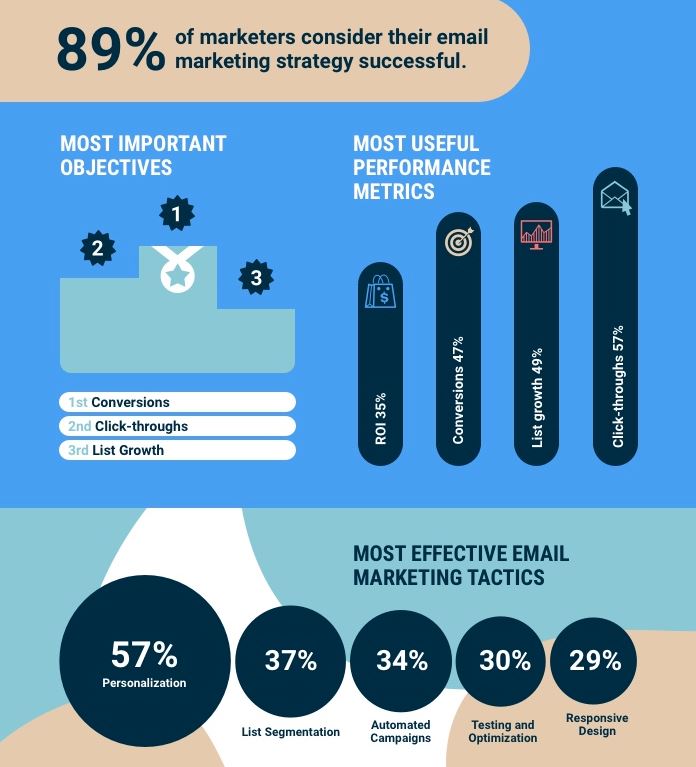Simply too adaptable to limit to one purpose or application, email marketing should be an important part of the mix of channels you use to help nurture prospect leads and further engage and retain your customers. Email can play a significant role as a component of specific campaigns and as a tool for ongoing communications with target audiences, cultivating relationships with meaningful content delivered on a regular basis. Read on to be inspired by real world applications and a web integration test you can put into action today.
Real World Applications
 If email isn’t a tactic you turn to for acquisition, retention and loyalty building efforts, it’s time to join the 89% of marketers who consider their email marketing strategy successful (source). Here’s where email can play an essential role within your integrated marketing efforts:
If email isn’t a tactic you turn to for acquisition, retention and loyalty building efforts, it’s time to join the 89% of marketers who consider their email marketing strategy successful (source). Here’s where email can play an essential role within your integrated marketing efforts:
- Add touch points and support your direct response programs, reiterating key messages and reminding recipients to respond.
- Create automated campaigns to keep in touch with prospects and move them along the buying cycle.
- Welcome new customers to the “family” and introduce them to the high level of service and value-added perks that they’ll soon experience.
- Keep a finger on the pulse of your customer base. It can invite them to further engage and keep in touch with your brand through social media or surveys.
- Retain customers with friendly, helpful reminders and tips. Recipients are far more likely to feel loyal to a brand that keeps their best interests in mind (e.g., service reminders – “time for a check-up!”).
- Offer a deeper level of education (building brand credibility and promoting thought leadership) through an eNewsletter format, complementing the organization’s offering of products/services.
- Put value-added content and tools in the hands of your customers. Innovative “extras” and guidance is a brand differentiator in today’s marketplace. But to get the most out of your investment, you need to ensure your customers are aware of and reminded about your nifty resources.
- To build your opt-in subscriber lists, incorporate relevant offers, simple opt-in forms and landing pages to compel sign-ups and collect high quality, accurate email addresses.
- Remember, data hygiene and segmentation are among the tactics necessary to improve message relevance, deliverability and open rates.
Build Your Opt-in List with the Help of Landing Pages
One effective way you can add high quality subscribers to your email marketing database is by pairing a valuable offer and landing page response mechanism.
Strategy
Rather than directing your direct response audiences (via social media, online advertising, direct mail, etc.) to the corporate website, drive them to a dedicated, highly targeted campaign landing page. The landing page will take on the look and feel of the opt-in campaign, incorporating your compelling offer and call-to-action. The tone of the copy, including headlines, subheads and calls-to-action, will be friendly, helpful and understanding.
Functionality
The landing page will embed a simple form to serve as the primary response mechanism. Your primary call-to-action will encourage visitors to complete the online form, including email address, to receive your offer and opt-in to future emails. Ideally, the form will feed the subscriber’s data right into your email marketing platform.
Form Data
The new form will require key contact information including name, mailing address, email address, etc. However, to address some web users’ concerns regarding their privacy and what you do with their personal information, be sure to include a brief, reassuring explanation as to what they can expect and a link to your privacy policy and terms of use.
SEO & Analytics
The web page should be search engine optimized to drive traffic from Google, Bing, Yahoo and other search engine users searching on the topic of your web page. Your traffic analytics will show you the traffic coming in from organic search vs. direct or referred visits.
Segment & Email
Now that your prospect has raised his or her hand and provided you with contact info, you have the opportunity to further qualify and segment them. Emailing a survey to gather additional information is one tactic. Another is to use a polling feature within your email marketing platform. Or, tracking clickthroughs on specific topics featured in your email communications. Further segmenting your subscribers is a great way to create more relevant, persuasive content that truly resonates with various types of recipients and gets them to take action.
With a proactive, strategic plan in place, there’s nearly no limit to how you can utilize email communications to achieve a variety of marketing and sales objectives.






